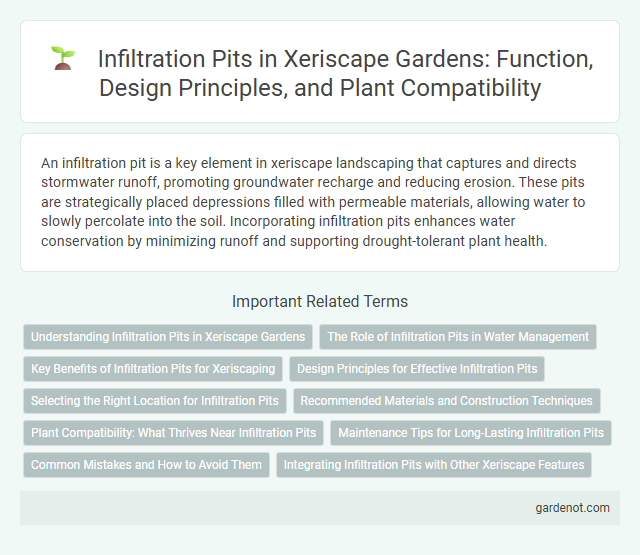An infiltration pit is a key element in xeriscape landscaping that captures and directs stormwater runoff, promoting groundwater recharge and reducing erosion. These pits are strategically placed depressions filled with permeable materials, allowing water to slowly percolate into the soil. Incorporating infiltration pits enhances water conservation by minimizing runoff and supporting drought-tolerant plant health.
Understanding Infiltration Pits in Xeriscape Gardens
Infiltration pits are essential components in xeriscape gardens, designed to capture and absorb stormwater runoff, reducing soil erosion and replenishing groundwater. These pits are excavated depressions filled with gravel or porous materials that promote water infiltration into the surrounding soil. Proper placement and sizing of infiltration pits enhance water conservation by optimizing natural irrigation in drought-prone landscapes.
The Role of Infiltration Pits in Water Management
Infiltration pits play a crucial role in xeriscape water management by capturing and directing stormwater runoff into the ground, reducing surface water accumulation and promoting groundwater recharge. These pits enhance soil moisture retention and mitigate erosion by slowing water flow and allowing gradual infiltration. Properly designed infiltration pits support sustainable landscaping practices by minimizing water waste and improving overall ecosystem health.
Key Benefits of Infiltration Pits for Xeriscaping
Infiltration pits enhance water conservation in xeriscaping by capturing and directing runoff into the soil, reducing erosion and promoting groundwater recharge. These pits improve soil moisture retention, supporting drought-resistant plants while minimizing the need for supplementary irrigation. Their strategic placement helps manage stormwater effectively, contributing to sustainable landscaping and reduced urban runoff impacts.
Design Principles for Effective Infiltration Pits
Infiltration pits, essential components of xeriscape design, maximize stormwater capture by utilizing soil permeability and natural filtration processes. Effective design principles include sizing pits based on local rainfall data and watershed area, incorporating coarse gravel layers to enhance percolation, and situating pits away from foundations to prevent structural damage. Strategic placement within landscape contours ensures optimal water absorption, reducing runoff and promoting groundwater recharge.
Selecting the Right Location for Infiltration Pits
Selecting the right location for infiltration pits involves assessing soil permeability, slope, and proximity to structures to ensure effective stormwater management. Areas with well-draining sandy or loamy soils are ideal, while steep slopes or compacted clay soils should be avoided to prevent erosion and poor infiltration. Proper siting maximizes water absorption and reduces runoff, supporting sustainable xeriscape landscaping.
Recommended Materials and Construction Techniques
Infiltration pits for xeriscaping should utilize coarse, permeable materials such as gravel, crushed stone, or coarse sand to maximize water absorption and prevent clogging. Constructing the pit with a geotextile fabric liner helps control sediment infiltration while maintaining permeability. Proper excavation to a depth of 2 to 4 feet ensures sufficient storage capacity and optimizes groundwater recharge.
Plant Compatibility: What Thrives Near Infiltration Pits
Plants thriving near infiltration pits typically include deep-rooted native grasses and drought-tolerant shrubs that enhance water absorption and reduce runoff. Species such as California lilac, manzanita, and certain sedums efficiently utilize the moist, well-drained environment created by infiltration pits. These plants not only improve infiltration pit function but also contribute to xeriscape sustainability by minimizing irrigation needs.
Maintenance Tips for Long-Lasting Infiltration Pits
Regularly remove debris and sediment from infiltration pits to prevent clogging and ensure efficient water absorption. Inspect the pit's lining and surrounding soil for erosion or compaction, addressing any issues promptly to maintain permeability. Use gravel or crushed stone layers as a natural filter, reducing sediment buildup and prolonging the pit's lifespan.
Common Mistakes and How to Avoid Them
Infiltration pits often fail due to improper sizing and poor soil assessment, leading to inadequate water absorption and potential overflow. Ensuring the pit dimensions match the catchment area and conducting thorough percolation tests prevent these issues. Regular maintenance to remove sediment buildup keeps infiltration pits functional and effective in xeriscape water management.
Integrating Infiltration Pits with Other Xeriscape Features
Integrating infiltration pits with xeriscape features enhances water conservation by capturing and directing runoff into the soil, reducing irrigation needs and preventing erosion. Positioning infiltration pits near drought-tolerant plants and permeable mulches increases soil moisture retention and supports healthy root growth. Combining these pits with rain gardens and native vegetation creates a synergistic system that maximizes natural water infiltration and landscape resilience.
Infiltration pit Infographic

 gardenot.com
gardenot.com